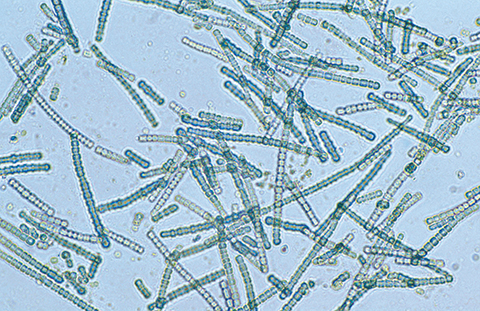From the journals: MCP
A new enzyme is unlocked in bacterial photosynthesis. A molecular target for alcohol consumption is uncovered. A special issue offers new perspectives in ECM research. Read about these papers recently published in the journal Molecular & Cellular Proteomics.
New enzyme unlocked in bacterial photosynthesis

Cyanobacteria, unique organisms capable of plant-like photosynthesis, are vital for producing oxygen and sustaining life on Earth. One specific cyanobacterial type, Synechocystis, was the first photosynthetic bacterium to be sequenced and is widely used as a model organism for studying photosynthesis and biotechnological applications.
Recent research has highlighted the significance of posttranslational modifications, or PTMs, in regulating photosynthesis in both cyanobacteria and plants. Lysine methylation, a specific PTM involving the addition of a methyl group to a protein's amino acid, has diverse functions in organisms. While researchers have studied it extensively in eukaryotes, they do not yet fully understand its role in bacteria (including cyanobacteria).
Gaoxiang Cao and a team at the Chinese Academy of Sciences in Wuhan recently analyzed the proteins in Synechocystis that have lysine methylation and found many proteins involved in photosynthesis that can be modified in this way. This reversible modification may play a role in regulating photosynthesis in both cyanobacteria and plants. However, researchers had not yet characterized the enzymes responsible for adding and removing the methyl group.
Lysine methyltransferase, or KMT, enzymes help with the transfer of methyl groups from S-adenosyl methionine molecules to proteins. The team focused on Synechocystisand unveiled a novel KMT named cKMT1. Experiments showed that cKMT1 could add methyl groups to lysine residues in proteins, both in controlled laboratory settings and within cells. Additionally, the researchers observed that cKMT1 modifies a crucial protein called ferredoxin-NADP(+) oxidoreductase and influences its activity, indicating its role in regulating energy transfer in Synechocystis.
The findings, recently published in the journal Molecular & Cellular Proteomics, provide insights into the regulation of photosynthesis in cyanobacteria. Understanding this new KMT and its function enhances our global comprehension of photosynthesis and holds promise for future potential biotechnological applications.
Molecular target for alcohol consumption uncovered
Protein kinase C epsilon, or PKCε, a crucial signaling molecule within cells, plays a significant role in transmitting signals and influences various cellular functions. In research studies, it has been particularly implicated in modulating behavioral responses to alcohol consumption and anxiety.
Michael P. Dugan and a team at the University of Texas at Austin conducted a study using innovative techniques to explore PKCε's role in alcohol and anxiety. They used chemical-genetic methods and mass spectrometry on mouse brain lysates, identifying 39 protein substrates directly interacting with PKCε, including known and novel interactors.
Among those known to interact with PKCε (such as myristoylated alanine-rich C-kinase substrate), associations were found with alcohol-related and anxiety-related behaviors. Additionally, numerous novel PKCε substrates (such as BR serine/threonine kinase 1 and Abelson interactor 1) emerged that were unrelated to alcohol and anxiety but involved in critical cellular functions, such as cytoskeleton maintenance and synaptic activity.
The study , published in Molecular & Cellular Proteomics, presents a list of proteins that could be potential targets for developing drugs to reduce alcohol consumption and anxiety in humans. Furthermore, these proteins may serve as biomarkers to detect abnormal PKCε activity in diseases like cancer and Alzheimer's, paving the way for new therapeutic avenues.
Perspectives in ECM research
The extracellular matrix, or ECM, forms the structural framework of multicellular organisms and functions as a signaling platform that influences processes such as proliferation, survival and differentiation. Imbalances in ECM production, degradation and remodeling can lead to disorders such as muscular dystrophy, fibrosis and cancer.
A recent special issue of the journal Molecular & Cellular Proteomics highlights accomplishments in ECM research over the past decade and looks at future research. Alexandra Naba of the University of Illinois at Chicago writes in her review that an improved understanding of the biochemical properties of ECM proteins has led researchers to develop strategies such as bottom-up proteomics to decode the compositional complexity of the ECM of tissues.
Researchers have also improved sample preparation and identification methods; these include enrichment strategies, such as solubility-based fractionation, developed to analyze the ECM composition in various tissues. Tandem-mass labels and peptide fractionation methods such as high-pH reversed-phase liquid chromatography have also been improved to identify and measure ECM proteins.
Researchers postulate that ECM proteomics is ready for anext chapter and clinical applications. Through proteomic profiling, researchers can better understand the ECM physiology and uncover proteins playing functional roles in disease etiology, which could serve as diagnostic biomarkers and therapeutic targets.
Enjoy reading ASBMB Today?
Become a member to receive the print edition four times a year and the digital edition monthly.
Learn moreGet the latest from ASBMB Today
Enter your email address, and we’ll send you a weekly email with recent articles, interviews and more.
Latest in Science
Science highlights or most popular articles

Bacteriophage protein could make queso fresco safer
Researchers characterized the structure and function of PlyP100, a bacteriophage protein that shows promise as a food-safe antimicrobial for preventing Listeria monocytogenes growth in fresh cheeses.

Building the blueprint to block HIV
Wesley Sundquist will present his work on the HIV capsid and revolutionary drug, Lenacapavir, at the ASBMB Annual Meeting, March 7–10, in Maryland.

Gut microbes hijack cancer pathway in high-fat diets
Researchers at the Feinstein Institutes for Medical Research found that a high-fat diet increases ammonia-producing bacteria in the gut microbiome of mice, which in turn disrupts TGF-β signaling and promotes colorectal cancer.

Mapping fentanyl’s cellular footprint
Using a new imaging method, researchers at State University of New York at Buffalo traced fentanyl’s effects inside brain immune cells, revealing how the drug alters lipid droplets, pointing to new paths for addiction diagnostics.

Designing life’s building blocks with AI
Tanja Kortemme, a professor at the University of California, San Francisco, will discuss her research using computational biology to engineer proteins at the 2026 ASBMB Annual Meeting.

Cholesterol as a novel biomarker for Fragile X syndrome
Researchers in Quebec identified lower levels of a brain cholesterol metabolite, 24-hydroxycholesterol, in patients with fragile X syndrome, a finding that could provide a simple blood-based biomarker for understanding and managing the condition.

